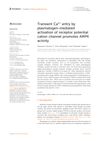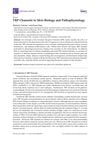Atypical Hippocampal Glutamate Receptor Coupled to Phospholipase D Controlling Stretch-Sensitivity in Primary Mechanosensory Nerve Endings Is Homomeric Purely Metabotropic GluK2
September 2023
in “
Experimental physiology
”

TLDR A special receptor in sensory nerve endings helps control how they respond to stretching.
The study identifies the phospholipase D-coupled metabotropic glutamate receptor (PLD-mGluR), a receptor essential for maintaining stretch responsiveness in muscle spindle mechanosensory primary endings, as a homomeric GluK2 receptor signaling metabotropically. This receptor was found in spindle primary sensory terminals and in the lanceolate palisade ending of hair follicles. The study also found that GluK2 mediates an automatic gain-control mechanism within the sensory terminal, regulating the availability or responsiveness of the transducer element(s). The study suggests that GluK2's purely metabotropic function may indicate GluK2 subunits act in a dimeric configuration. This novel arrangement would explain its novel functionality and resistance to characterization until now.



